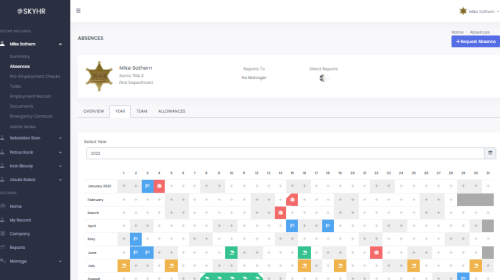Understanding how many working weeks are in a year is crucial for a myriad of reasons, whether you’re clocking in as an employee, orchestrating the workforce as an HR professional, or steering the helm of a business. This knowledge is the bedrock of effective annual leave planning, accurate salary computations, and seamless workforce management. But, in a landscape marked by statutory and other types of leave, bank holidays, and a variety of employment contracts, how does one navigate the calculation of working weeks in the UK?
The Standard Working Year in the UK
At its core, the UK work calendar is structured around a standard full-time working schedule of 37.5 to 40 hours spread across 5 working days a week. However, when you factor in statutory annual leave and public holidays, the number of actual working weeks sees a reduction. Typically, excluding these breaks, there are about 46 to 48 working weeks annually for a full-time employee.
Accounting for Public Holidays
Public holidays, or bank holidays as they’re often known, play a significant role in determining the number of working weeks. The UK observes around 8 public holidays, with some regional variations – for instance, Scotland enjoys a couple more. It’s essential to account for these days off when calculating your working weeks since most businesses shut down during these times, reducing the number of working days in a year.
Annual Leave Entitlements
In the UK, the understanding and management of annual leave entitlements form a cornerstone of employment law, with significant implications for calculating working weeks. Full-time employees are entitled to a statutory minimum of 28 days of paid leave per year, which can include the eight public holidays, depending on the terms of the employment contract. However, many employers offer more generous leave allowances as part of their employment package, adding another layer of complexity to the calculation of working weeks.
Statutory Minimum Leave: The baseline for annual leave in the UK is set at 28 days for full-time employees, a figure that can encompass public bank holidays. This entitlement is pro-rated for part-time employees, ensuring equity regardless of working hours. For example, someone working three days a week would be entitled to 16.8 days of leave (28 days × 3/5).
Inclusion of Bank Holidays: The integration of bank holidays into annual leave is a common practice, but it’s not universal. Some employers choose to offer bank holidays in addition to the statutory leave entitlement, effectively extending the total leave and reducing the number of working weeks. This approach can vary significantly between industries and individual businesses, with some sectors, such as hospitality and healthcare, often requiring staff to work during public holidays, with compensatory leave or pay provided instead.
Carry-over Policies: Many organisations have policies that allow employees to carry over a certain amount of unused leave into the next year. This policy can affect the calculation of working weeks, as an individual may use carried-over leave to reduce their working weeks below the standard expectation in a given year.
Enhanced Leave Entitlements: Some companies offer enhanced leave entitlements as a perk or benefit, surpassing the statutory minimum. This additional leave can serve as an incentive and a means of promoting work-life balance but also alters the count of working weeks for those employees.
Part-time and Flexible Working Adjustments: For those not working traditional full-time hours, calculating annual leave entitlement requires a tailored approach. Leave must be pro-rated to reflect actual working hours, ensuring part-time and flexible workers receive a fair proportion of leave relative to their full-time counterparts. This adjustment ensures that all employees have equitable access to rest and recreation, regardless of their working pattern.
Calculating Leave Entitlement: To accurately calculate annual leave entitlement and its impact on working weeks, employees should consider their contract’s specifics, including how bank holidays are treated, any carry-over policies, and whether their employer offers additional leave. Understanding these details allows for a precise count of working weeks, facilitating better planning and time management.
The Impact of Part-Time Work
Part-time work represents a significant portion of the UK workforce, offering flexibility and accommodation for a variety of personal circumstances, from childcare responsibilities to further education. However, the variability in hours and schedules inherent to part-time employment introduces complexity into calculating working weeks, particularly when juxtaposed with full-time roles.
Pro-Rata Basis: Part-time employees’ annual leave, including bank holidays, is often calculated on a pro-rata basis relative to full-time entitlements. This means if a full-time employee is entitled to 28 days of leave, a part-time employee working half the hours would be entitled to 14 days. This pro-rata calculation extends to working weeks, requiring adjustments based on the fraction of full-time hours worked.
Varied Weekly Hours: Unlike full-time employees with a consistent number of weekly hours, part-time workers might have contracts that specify a minimum number of hours without guaranteeing consistency week-to-week. This fluctuation necessitates a more dynamic approach to counting working weeks, often requiring part-time workers to track their hours across the year to determine an accurate count of working weeks.
Bank Holidays: For part-time workers, the treatment of bank holidays can vary. Some employers allocate bank holiday entitlement on a pro-rata basis, which might mean a part-time worker does not receive a full day’s leave for each bank holiday, but rather a fraction thereof, again dependent on their working hours.
Contractual and Voluntary Overtime: Many part-time roles include the possibility of overtime, which can blur the lines between part-time and full-time working weeks during busy periods. While contractual overtime might be expected to some degree, voluntary overtime offers part-time workers the flexibility to extend their working weeks as needed, impacting the overall calculation of working weeks in a year.
Impact on Benefits: The number of working weeks can also influence entitlement to certain employment benefits, which may be contingent upon the number of hours worked or the pro-rata equivalence of full-time employment. Part-time workers need to be aware of how their working weeks impact their eligibility for such benefits.
Flexibility and Work-Life Balance: The very essence of part-time work is its flexibility, allowing employees to balance work with other life commitments. However, this flexibility means that part-time workers need to be more vigilant in managing their working weeks to ensure they meet their contractual obligations while maintaining the intended balance between work and personal life.
In summary, part-time employment necessitates a nuanced approach to calculating working weeks, taking into account pro-rata entitlements, the variability of hours, and the impact on employment benefits. Accurate tracking and open communication with employers are crucial for part-time workers to navigate their schedules and entitlements effectively.
Special Considerations
When calculating working weeks, it’s crucial to acknowledge that not all employment scenarios fit neatly into the standard full-time framework. The UK’s diverse employment landscape includes a range of work patterns, contracts, and industry-specific practices, each with its unique implications for how working weeks are counted.
Shift Work and Irregular Hours: Many sectors, notably healthcare, emergency services, and hospitality, rely heavily on shift work. This can mean working nights, weekends, and even public holidays, deviating significantly from the conventional Monday-to-Friday workweek. For shift workers, a “working week” might encompass a different range of days or a varying number of hours, making it essential to consider the total hours worked over a year rather than merely counting weeks.
Zero-hour Contracts: Particularly prevalent in the retail and hospitality industries, zero-hour contracts present a challenge for calculating working weeks, as there’s no guaranteed minimum number of working hours per week. Individuals on these contracts must often adopt a more flexible approach, tracking their working weeks based on the actual hours worked, which can vary widely from one week to the next.
Seasonal Employment: In sectors driven by seasonal demand, such as tourism and agriculture, workers might experience intense periods of work followed by downtime. For seasonal employees, the number of working weeks is concentrated in specific parts of the year, necessitating a tailored approach to calculating working time and leave entitlements.
Freelancers and the Self-Employed: For those who are self-employed or freelance, defining a “working week” can be more fluid, with work often ebbing and flowing in response to demand. While not bound by the same statutory leave regulations as employees, freelancers still benefit from considering their working weeks for personal time management and work-life balance.
Industry-specific Regulations: Certain professions are subject to specific regulatory frameworks that dictate working hours, rest periods, and, by extension, the calculation of working weeks. For example, regulations in the transport sector cap driving hours for safety reasons, affecting how working weeks are tallied.
Contractual Variations: Employment contracts can vary significantly, with some including clauses for mandatory overtime, on-call periods, or standby duty. These stipulations can extend the working week beyond the typical boundaries, necessitating careful consideration in workforce planning.
Educational Institutions: In the academic sector, terms and semesters dictate the rhythm of work, particularly for teaching staff. The academic year, punctuated by holidays and breaks, requires a bespoke approach to defining working weeks.
When navigating these special considerations, it’s essential to maintain a dialogue with employers or clients to ensure a mutual understanding of working patterns and expectations. Additionally, leveraging HR software and tools can help manage these complexities, providing clarity and consistency in counting working weeks across varied employment scenarios.
Calculating How Many Working Weeks are in a Year
Delving into the task of calculating your working weeks requires a methodical approach, especially in a landscape as varied as the UK’s employment sector. Whether you’re full-time, part-time, or navigating the waters of flexible working, understanding your working weeks is pivotal for planning holidays, managing work-life balance, and ensuring you’re within your contractual obligations.
Start with the Basics:
Begin with the standard assumption of a 52-week year. This is your starting point before any deductions are made for holidays and leave.
Factor in Public Holidays:
The UK observes around 8 public holidays, with some variations depending on where in the UK you are. Deduct these from your total if your employment terms state that these are not part of your annual leave. Remember, some businesses may close, allowing staff an additional day off without it impacting their annual leave balance.
Deduct Annual Leave:
Full-time employees are entitled to a minimum of 28 days of paid leave, which might include public holidays. Subtract this from the total number of weeks in the year, prorating if necessary for part-time roles. For example, if you work three days a week, your annual leave entitlement would be 3/5 of 28 days.
Consider Part-Time or Flexible Working:
If you’re not working a standard full-time schedule, calculate your working weeks based on your contracted hours. For instance, if you work 20 hours a week instead of the standard 37.5 or 40, adjust your calculations accordingly. Remember to prorate your public holidays and annual leave to reflect your working pattern.
Account for Unpaid Leave or Sabbaticals:
If you plan to take a career break, sabbatical, or unpaid leave, these weeks should also be deducted from your total. Such breaks can significantly impact your count of working weeks, especially in careers where long sabbaticals are common.
Special Circumstances:
For those in industries with non-standard work patterns, like shift work or roles requiring weekend availability, calculating working weeks can be more complex. In these cases, consider each week you are scheduled to work, regardless of the days, as a working week.
Utilise Tools and Software:
Leverage HR software and tools that can automate much of this calculation, taking into account your specific employment terms and conditions. These platforms often offer features that can track your work schedule, annual leave, and public holidays, providing a clear view of your working weeks at a glance.
By systematically breaking down the components of your working year and adjusting for your specific circumstances, you can arrive at an accurate count of your working weeks. This not only aids in personal planning but also ensures transparency and fairness in employment practices, particularly when managing leave and workloads.
Tools and Resources for Planning
Navigating the maze of working weeks, annual leave, and public holidays can be streamlined with the right tools. HR software solutions like SkyHR offer a suite of features designed to assist in planning and tracking working weeks, managing leave entitlements, and ensuring compliance with employment regulations.
Conclusion
Grasping the concept of working weeks in the UK, with its blend of statutory entitlements and diverse working patterns, is key to managing your professional and personal life harmoniously. Armed with this knowledge and the right tools, employees and employers alike can foster a more structured and efficient working environment.




